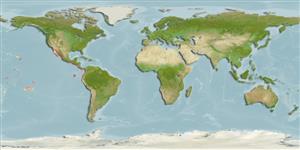Common names from other countries
>
Carangiformes (Jacks) >
Carangidae (Jacks and pompanos) > Scomberoidinae
Etymology: Oligoplites: Greek, oligos = small + Greek, hoplites = armed (Ref. 45335).
More on author: Günther.
Environment: milieu / climate zone / depth range / distribution range
Ecologia
marinhas; estuarina bentopelágico. Tropical; 32°N -
Eastern Pacific: Mexico to Peru.
Tamanho / Peso / Idade
Maturity: Lm ? range ? - ? cm
Max length : 56.0 cm FL macho/indeterminado; (Ref. 40637); common length : 30.0 cm FL macho/indeterminado; (Ref. 9283); peso máx. Publicado: 1.6 kg (Ref. 40637)
Descrição breve
Chaves de identificação | Morfologia | Morfometria
Body elongate, fairly deep, and compressed (depth from 2.5 to 3.4 times in standard length); posterior edge of upper jaw extending beyond posterior rim of eye; upper jaw teeth small and villiform; lower branch of first gill arch with 8 to 13 gill rakers; scales small but visible, needle-shaped, embedded in the skin; body gray or brown; flanks and belly silvery with yellow highlights (Ref. 55763).
Adults inhabit coastal waters, entering estuaries (Ref. 9283). Dorsal and anal spines of this species are connected to venomous glands that may inflict painful wounds (Ref. 9283). Marketed fresh and salted or dried (Ref. 9283).
Life cycle and mating behavior
Maturities | Reprodução | Spawnings | Egg(s) | Fecundities | Larvas
Smith-Vaniz, W.F., 1995. Carangidae. Jureles, pámpanos, cojinúas, zapateros, cocineros, casabes, macarelas, chicharros, jorobados, medregales, pez pilota. p. 940-986. In W. Fischer, F. Krupp, W. Schneider, C. Sommer, K.E. Carpenter and V. Niem (eds.) Guia FAO para Identification de Especies para lo Fines de la Pesca. Pacifico Centro-Oriental. 3 Vols. FAO, Rome. (Ref. 9283)
Categoria na Lista Vermelha da IUCN (Ref. 130435)
CITES (Ref. 128078)
Not Evaluated
Utilização humana
Pescarias: espécies comerciais
Ferramentas
Relatórios especiais
Descarregue XML
Fontes da internet
Estimates based on models
Preferred temperature (Ref.
115969): 20 - 28.4, mean 24.9 (based on 70 cells).
Phylogenetic diversity index (Ref.
82804): PD
50 = 0.5312 [Uniqueness, from 0.5 = low to 2.0 = high].
Bayesian length-weight: a=0.00871 (0.00523 - 0.01450), b=2.96 (2.82 - 3.10), in cm Total Length, based on LWR estimates for this species & Genus-body shape (Ref.
93245).
Nível Trófico (Ref.
69278): 4.1 ±0.0 se; based on diet studies.
Resiliência (Ref.
120179): Médio, tempo mínimo de duplicação da população 1,4 - 4,4 anos (Preliminary K or Fecundity.).
Fishing Vulnerability (Ref.
59153): Moderate vulnerability (45 of 100).
